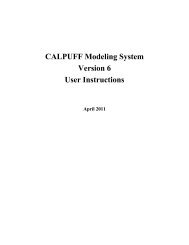Volume 1 - The Atmospheric Studies Group at TRC
Volume 1 - The Atmospheric Studies Group at TRC
Volume 1 - The Atmospheric Studies Group at TRC
Create successful ePaper yourself
Turn your PDF publications into a flip-book with our unique Google optimized e-Paper software.
<strong>The</strong> UP.DAT (upper-air) input file is designed to provide CALMET with vertical<br />
profiles of wind and temper<strong>at</strong>ure represent<strong>at</strong>ive of the onshore flow <strong>at</strong> 00Z (mid to<br />
l<strong>at</strong>e afternoon) during the tracer sampling. Both 00Z and 12Z vertical profiles of<br />
wind and temper<strong>at</strong>ure are developed for four levels: surface, 10m, overw<strong>at</strong>er mixing<br />
height, and model-top (3000m). <strong>The</strong> 00Z wind speed <strong>at</strong> 9m is extended to levels up to<br />
the mixing height using a stability-class-dependent power-law profile (A,B=0.07;<br />
C=0.10; D,E,F=0.15) and the speed <strong>at</strong> the model-top is set to th<strong>at</strong> <strong>at</strong> the mixing<br />
height. <strong>The</strong> surface wind speed is set to th<strong>at</strong> <strong>at</strong> 10m, which has been adjusted from<br />
the anemometer height to 10m.. Wind direction <strong>at</strong> all levels equals the release wind<br />
direction. Temper<strong>at</strong>ure <strong>at</strong> the surface equals the air temper<strong>at</strong>ure in the SEA.DAT file,<br />
and temper<strong>at</strong>ure aloft is computed from this using the temper<strong>at</strong>ure gradient dT/dz (in<br />
the SEA.DAT file) up to the overw<strong>at</strong>er mixing height. <strong>The</strong> default CALMET<br />
temper<strong>at</strong>ure gradient -0.0045 ºK/m is used above the mixing height. Pressure is<br />
assumed to be 1013 mb <strong>at</strong> the surface, and decreases with height <strong>at</strong> 0.1 mb/m.<br />
Pismo Beach, California<br />
Description<br />
<strong>The</strong> tracer dispersion study in the Pismo Beach, California area was conducted along<br />
the California coast during five test days in December 1981 and five test days in June<br />
1982 (Dabberdt et al., 1983, Brodzinsky et al., 1982, and Schacher et al., 1982). SF 6<br />
tracer was released about 13m above the w<strong>at</strong>er from a bo<strong>at</strong> loc<strong>at</strong>ed 6 to 8 km from<br />
shore, and sampled along an arc th<strong>at</strong> covered about 15 km of the shoreline. Several<br />
samplers were also loc<strong>at</strong>ed along a shorter secondary arc approxim<strong>at</strong>ely 7 km inland.<br />
Evalu<strong>at</strong>ion of OCD4 with this d<strong>at</strong>aset focused on the one-hour average<br />
concentr<strong>at</strong>ions measured <strong>at</strong> the shoreline.<br />
Meteorological d<strong>at</strong>a used in the OCD4 evalu<strong>at</strong>ion d<strong>at</strong>aset includes wind <strong>at</strong> 20.5m,<br />
temper<strong>at</strong>ure <strong>at</strong> 7m, and air-sea temper<strong>at</strong>ure difference measured <strong>at</strong> the release<br />
loc<strong>at</strong>ion, and vertical temper<strong>at</strong>ure gradient measured over the w<strong>at</strong>er by an aircraft.<br />
Geophysical Processing<br />
Gridded land use and terrain elev<strong>at</strong>ion d<strong>at</strong>a for the CALMET geophysical file are<br />
obtained from the USGS. <strong>The</strong> terrain d<strong>at</strong>a are from the one-degree 1:250,000-scale<br />
DEM d<strong>at</strong>aset, with an approxim<strong>at</strong>e resolution of 90m. Land use d<strong>at</strong>a are from the<br />
1:250,000-scale CTG d<strong>at</strong>aset, with a resolution of 200m. Because the sp<strong>at</strong>ial<br />
vari<strong>at</strong>ion in land use is the primary geophysical property for this applic<strong>at</strong>ion, a<br />
modeling grid is chosen th<strong>at</strong> places each land use d<strong>at</strong>apoint in the center of a model<br />
grid cell. <strong>The</strong> modeling grid chosen to cover the area is defined by:<br />
Map Projection: UTM (Zone 10N)<br />
Final Report Vol.1 38







